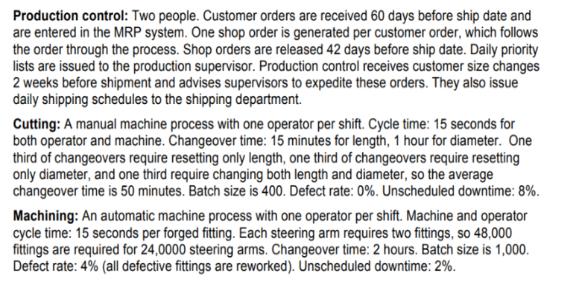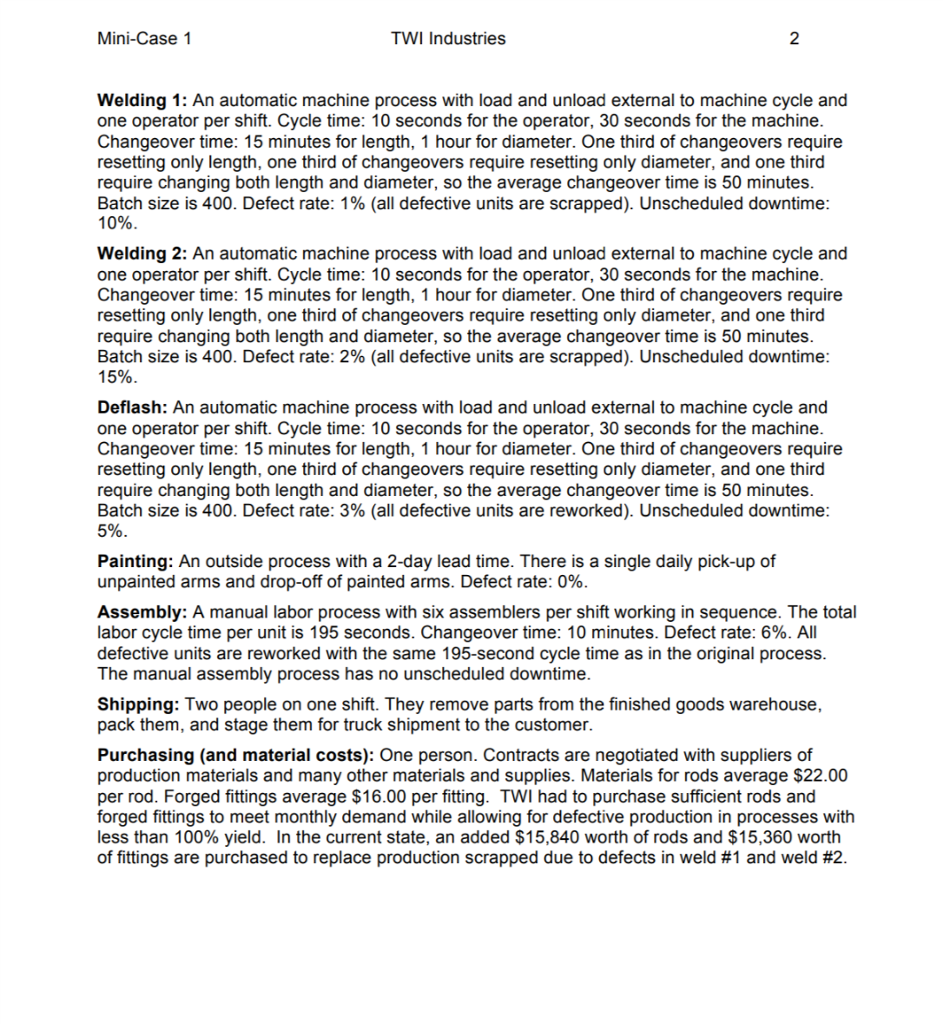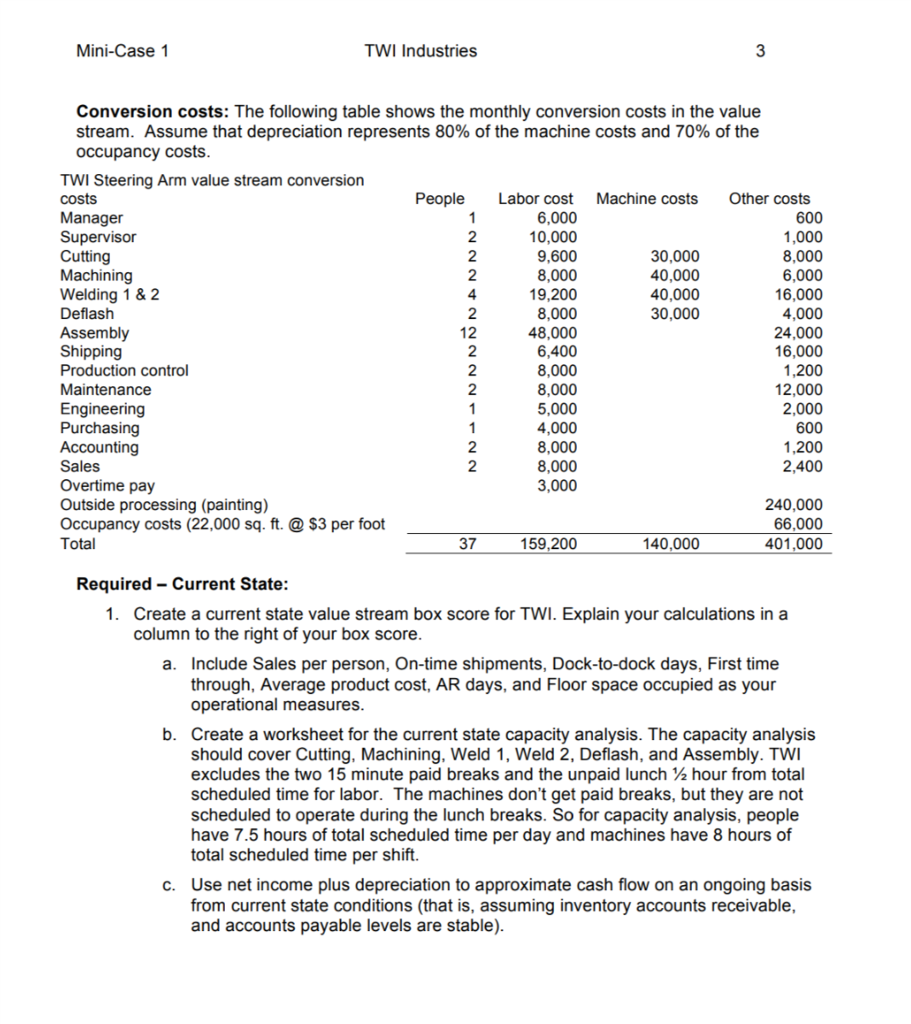Answered step by step
Verified Expert Solution
Question
1 Approved Answer
The Steering Arm Value Stream produces TWI's steering arms. A steering arm is a metal rod with a forged fitting welded to each end.




The Steering Arm Value Stream produces TWI's steering arms. A steering arm is a metal rod with a forged fitting welded to each end. The steering arms are available in 20 different lengths, 2 different diameters and with 3 different types of end fittings (each end may have a different fitting) yielding a total of 240 different part numbers in the steering arm product family. The average selling price is $110 per steering arm. Customers order 24,000 steering arms per month. Each customer order is for 25- 200 steering arms, with an average of 50 steering arms per order. Each customer's configuration requirements (part numbers and quantities) vary greatly from order to order. The orders are packed in corrugated boxes with each box containing up to 5 steering arms. TWI quotes a lead- time of 60 days. Customers often adjust their size mix two weeks before the shipping date. TWI currently has a 72% on time delivery rate. Their accounting records at the end of the period show an accounts receivable balance of $5,754,000 and an inventory balance of $3,443,300. TWI's steering arm production process requires cutting a metal rod, machining forged end fittings, welding the end fittings to the rods and deflashing (a process to remove excess weldment). The deflashed arms are then sent to an outside contractor for painting. The painted arms return from the contractor to a manual fitting assembly process. The completed arms go to shipping, where they are packed and staged for shipping. The process, including space for inventory, uses 22,000 square feet. Work time is 20 days per month, 8 hours per day, with two shifts in all production departments and overtime, if necessary. Workers have two 15-minute breaks per shift, and 30 minutes (unpaid) for lunch. Machines are not run during the unpaid lunch breaks, but the automatic machines can operate through the 15-minute morning and afternoon breaks. The manually operated cutting machine is not operated during breaks. Operators and assemblers spend the first fifteen minutes of each shift at a production meeting, and the last 10 minutes of each shift engaged in cleaning and 5S activity. On average, the operators and assemblers spend 20 minutes each day gathering and reporting data, and filling out reports. Machines are not running during the production meetings or the 5S and cleanup activity. Automatic machinery can be running while operators are gathering and reporting data. When machinery is down for repair, operators are occupied with trouble-shooting and bringing the machinery back on line. Production control: Two people. Customer orders are received 60 days before ship date and are entered in the MRP system. One shop order is generated per customer order, which follows the order through the process. Shop orders are released 42 days before ship date. Daily priority lists are issued to the production supervisor. Production control receives customer size changes 2 weeks before shipment and advises supervisors to expedite these orders. They also issue daily shipping schedules to the shipping department. Cutting: A manual machine process with one operator per shift. Cycle time: 15 seconds for both operator and machine. Changeover time: 15 minutes for length, 1 hour for diameter. One third of changeovers require resetting only length, one third of changeovers require resetting only diameter, and one third require changing both length and diameter, so the average changeover time is 50 minutes. Batch size is 400. Defect rate: 0%. Unscheduled downtime: 8%. Machining: An automatic machine process with one operator per shift. Machine and operator cycle time: 15 seconds per forged fitting. Each steering arm requires two fittings, so 48,000 fittings are required for 24,0000 steering arms. Changeover time: 2 hours. Batch size is 1,000. Defect rate: 4% (all defective fittings are reworked). Unscheduled downtime: 2%. Mini-Case 1 TWI Industries 2 Welding 1: An automatic machine process with load and unload external to machine cycle and one operator per shift. Cycle time: 10 seconds for the operator, 30 seconds for the machine. Changeover time: 15 minutes for length, 1 hour for diameter. One third of changeovers require resetting only length, one third of changeovers require resetting only diameter, and one third require changing both length and diameter, so the average changeover time is 50 minutes. Batch size is 400. Defect rate: 1% (all defective units are scrapped). Unscheduled downtime: 10%. Welding 2: An automatic machine process with load and unload external to machine cycle and one operator per shift. Cycle time: 10 seconds for the operator, 30 seconds for the machine. Changeover time: 15 minutes for length, 1 hour for diameter. One third of changeovers require resetting only length, one third of changeovers require resetting only diameter, and one third require changing both length and diameter, so the average changeover time is 50 minutes. Batch size is 400. Defect rate: 2% (all defective units are scrapped). Unscheduled downtime: 15%. Deflash: An automatic machine process with load and unload external to machine cycle and one operator per shift. Cycle time: 10 seconds for the operator, 30 seconds for the machine. Changeover time: 15 minutes for length, 1 hour for diameter. One third of changeovers require resetting only length, one third of changeovers require resetting only diameter, and one third require changing both length and diameter, so the average changeover time is 50 minutes. Batch size is 400. Defect rate: 3% (all defective units are reworked). Unscheduled downtime: 5%. Painting: An outside process with a 2-day lead time. There is a single daily pick-up of unpainted arms and drop-off of painted arms. Defect rate: 0%. Assembly: A manual labor process with six assemblers per shift working in sequence. The total labor cycle time per unit is 195 seconds. Changeover time: 10 minutes. Defect rate: 6%. All defective units are reworked with the same 195-second cycle time as in the original process. The manual assembly process has no unscheduled downtime. Shipping: Two people on one shift. They remove parts from the finished goods warehouse, pack them, and stage them for truck shipment to the customer. Purchasing (and material costs): One person. Contracts are negotiated with suppliers of production materials and many other materials and supplies. Materials for rods average $22.00 per rod. Forged fittings average $16.00 per fitting. TWI had to purchase sufficient rods and forged fittings to meet monthly demand while allowing for defective production in processes with less than 100% yield. In the current state, an added $15,840 worth of rods and $15,360 worth of fittings are purchased to replace production scrapped due to defects in weld #1 and weld #2. Mini-Case 1 TWI Steering Arm value stream conversion costs Conversion costs: The following table shows the monthly conversion costs in the value stream. Assume that depreciation represents 80% of the machine costs and 70% of the occupancy costs. Manager Supervisor Cutting Machining Welding 1 & 2 Deflash Assembly Shipping Production control TWI Industries Maintenance Engineering Purchasing Accounting Sales Overtime pay Outside processing (painting) Occupancy costs (22,000 sq. ft. @ $3 per foot Total People 1 2 2 4 2 12 2 37 Labor cost 6,000 10,000 9,600 8,000 19,200 8,000 48,000 6,400 8,000 8,000 5,000 4,000 8,000 8,000 3,000 159,200 Machine costs 30,000 40,000 40,000 30,000 3 140,000 Other costs 600 1,000 8,000 6,000 16,000 4,000 24,000 16,000 1,200 12,000 2,000 600 1,200 2,400 240,000 66,000 401,000 Required Current State: 1. Create a current state value stream box score for TWI. Explain your calculations in a column to the right of your box score. a. Include Sales per person, On-time shipments, Dock-to-dock days, First time through, Average product cost, AR days, and Floor space occupied as your operational measures. b. Create a worksheet for the current state capacity analysis. The capacity analysis should cover Cutting, Machining, Weld 1, Weld 2, Deflash, and Assembly. TWI excludes the two 15 minute paid breaks and the unpaid lunch 1 hour from total scheduled time for labor. The machines don't get paid breaks, but they are not scheduled to operate during the lunch breaks. So for capacity analysis, people have 7.5 hours of total scheduled time per day and machines have 8 hours of total scheduled time per shift. c. Use net income plus depreciation to approximate cash flow on an ongoing basis from current state conditions (that is, assuming inventory accounts receivable, and accounts payable levels are stable).
Step by Step Solution
★★★★★
3.53 Rating (153 Votes )
There are 3 Steps involved in it
Step: 1
Answer current set up VSM Set Up 1 How long does it take to complete a Takt Each day is 15 hours long and each month is 20 days long a month of 300 hours per month 1080000 seconds Monthly demand 24000 ...
Get Instant Access to Expert-Tailored Solutions
See step-by-step solutions with expert insights and AI powered tools for academic success
Step: 2

Step: 3

Ace Your Homework with AI
Get the answers you need in no time with our AI-driven, step-by-step assistance
Get Started


